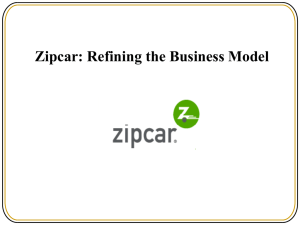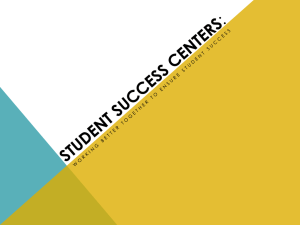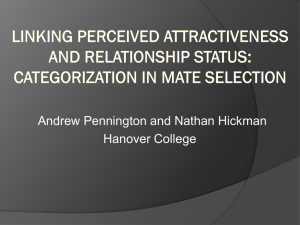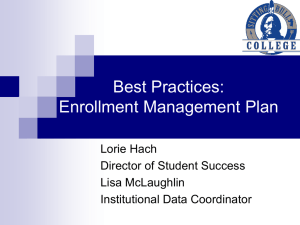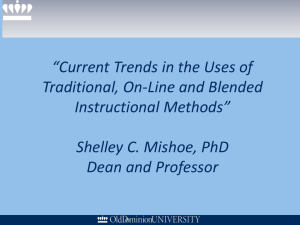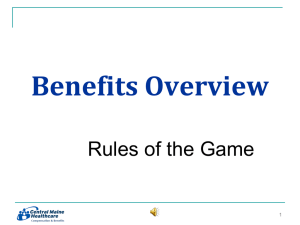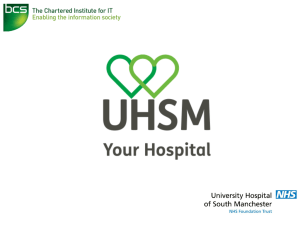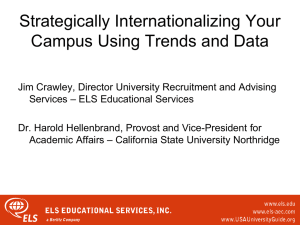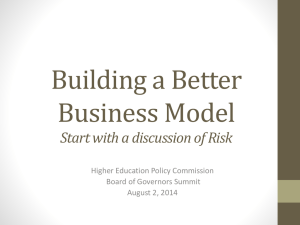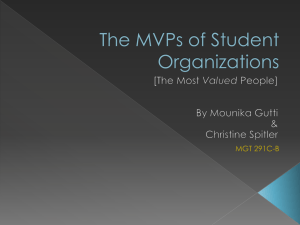Volk3-EnrolmentMgt - OK-AIR
advertisement
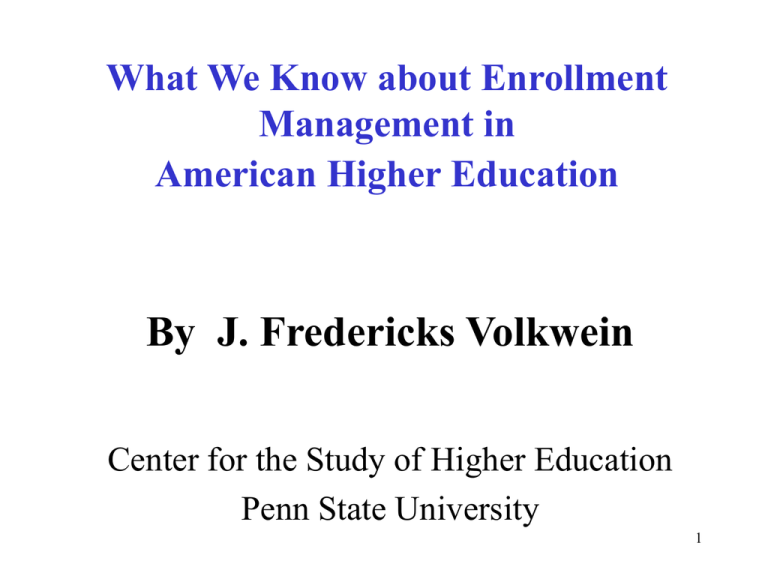
What We Know about Enrollment Management in American Higher Education By J. Fredericks Volkwein Center for the Study of Higher Education Penn State University 1 The Importance of Enrollment Management • E. M. has become a key strategic planning ingredient. • The financial health of public and private institutions alike are substantially enrollment-driven. • Student recruitment, admissions, enculturation, and education are expensive activities that become even more costly under conditions of high turnover. • E. M. serves as an important mechanism for promoting student-institution fit. • E. M. has become a means of accomplishing institutional effectiveness. 2 Volkwein, Penn State: CSHE THREE-STAGE Attracting, Admitting, and Enrolling Students ENROLLMENT MANAGEMENT MODEL Introduction and Integration Persistence, Graduation, Success 3 Volkwein- Penn State, CSHE Stage 1 Attracting, Admitting, and Enrolling Students THE TRADITIONAL CORE • Student College Choice and Fit • Admissions Marketing • Applications Management • Tuition Pricing • Financial Aid Packaging • Strategic Niche Building 4 Volkwein- Penn State, CSHE Stage 2 Introduction and Integration THE FIRST-YEAR EXPERIENCE • Orientation • Advisement • Curricular Access • Remediation • Support Services Volkwein- Penn State, CSHE 5 INSTITUTIONAL EFFECTIVENESS • Student Learning and Academic Performance • Satisfaction and Institutional Commitment • Student Tracking and Retention • Campus Climate • Alumni Studies • Improvement Stage 3 Persistence, Graduation, Success 6 Volkwein- Penn State, CSHE System Dynamics Model of University Enrollment, Financial and Faculty Resources An “Influence Diagram” Developed by Bruce P. Szelest, University at Albany with Assistance from J. Fredericks Volkwein, Penn State University and George P. Richardson, University at Albany. Relative Attractiveness Applicants Admits Enrollments Financial Resources Proportion of apps admitted Academic Reputation New Student Quality •The backbone of the Enrollment Management process can be depicted by a flow from Applications to Admits, to Enrollees, to Financial Resources. Financial Resources are increasingly enrollment dependent at public and private universities alike. •Student selectivity (the admissions rate or proportion of applicants admitted) drives the fundamental self-reinforcing process of university attractiveness via academic reputation and New Student Quality indicators like SAT/ACT scores and high school rank. •Dynamic Hypothesis: The admit fraction is a leverage point – adjusting the admit fraction is a shortterm control on the number of admits and also has longer-term implications for the university’s overall Relative Attractiveness via its inverse relationship with Freshman Quality Indicators—the lower the proportion of admitted applicants, the higher the Indicators, and the stronger the Academic Reputation. 7 Perceived Quality & Success Instruction & Related Activity Breadth & Depth of Academic Programs Student Retention FT Faculty & Adjuncts Relative Attractiveness Applicants Admits Enrollments Financial Resources Proportion of apps admitted Academic Reputation New Student Quality •Financial resources enable the institution to purchase a mix of Full-time and Part-time Faculty that perform Instructional & other activities (e.g., advisement, mentoring) which influence Student Retention and Student Success. These faculty instructional activities thus exert influences, not only on the number of current Enrollees, but also on future enrollments by influencing Institutional Attractiveness. Increasing the number of faculty enables the institution to increase the breadth and depth of its academic programs, as well as to increase instructional quality. •More resources enable the institution both to buy more faculty (thus lowering the student/faculty ratio) and to pay them higher salaries (thus raising faculty quality by hiring the best full-time and adjunct faculty that are available in the marketplace). Full-time Faculty provide more instructionally related activities than do Adjuncts, so the mix of Adjuncts & Full-time Faculty will therefore have implications for student retention. •Dynamic Hypothesis: Instruction and Instruction-Related Activities are a leverage point - increasing these activities can increase student retention and success, the enrollment level, curricular diversity, perceived quality, and relative attractiveness. 8 Academic Governance & Service Perceived Quality & Success Instruction & Related Activity Breadth & Depth of Academic Programs Student Retention FT Faculty & Adjuncts Relative Attractiveness Applicants Admits Enrollments Financial Resources Proportion of apps admitted Academic Reputation New Student Quality •Faculty may also invest their time in Academic Governance, Program Review, and other University Service Activities (e.g., honors programs, teaching and learning centers, faculty senates, curriculum committees). By improving the quality of instruction and strengthening educational policy, these activities eventually influence student retention and the perceived success of graduates, which affect university Relative Attractiveness. Thus, Faculty Academic Governance and Service activities can influence both current students (via retention) and prospective students (via attractiveness), thus increasing enrollment and financial resources. 9 Perceived Quality & Success Academic Governance &Service Instruction & Related Activity Breadth & Depth of Academic Programs Student Retention FT Faculty & Adjuncts Relative Attractiveness Applicants Admits Proportion of apps admitted Academic Reputation New Student Quality Perceived Faculty Quality Enrollments Financial Resources Indirect Cost Recovery Research Infrastructure Research & Scholarly Activity Spending on Research Infrastructure, which positively influences Research Activity, competes with spending for Adjuncts and Full-time Faculty. Research and Scholarly Activity also competes for the time of Full-time Faculty, and influences overall Relative Attractiveness by increasing Perceived Faculty Quality and Academic Reputation. Research Activity also promotes Indirect Cost Recovery which contributes positively to Financial Resources. •Dynamic Hypothesis: Expenditures on Research Infrastructure are a leverage point. Expenditures on Research Infrastructure positively influence Research and scholarly activity as well as indirect cost recovery. Faculty instruction and academic governance service exerts the greatest influence on current students; and faculty research and scholarship exerts the greatest influence on perceived faculty quality and academic reputation. Both sets of faculty activity increase the attractiveness of the institution to prospective students, thus strengthening enrollment and financial resources. 10 Perceived Quality & Success Academic Governance &Service Instruction & Related Activity Breadth & Depth of Academic Programs Student Retention FT Faculty & Adjuncts Relative Attractiveness Applicants Admits Proportion of apps admitted Academic Reputation New Student Quality Perceived Faculty Quality Enrollments Financial Resources Indirect Cost Recovery Other Financial Expenditures Research Infrastructure Research & Scholarly Activity Outreach & Public Service Exp. Other Financial Expenditures include investments in External Outreach and Public Service (especially common in fields like agriculture, business, education, engineering, public administration, and distance education). Spending for Outreach and Public Service competes with spending for Faculty and Research Infrastructure. Public Service and Outreach Activity also competes for the time of Full-time Faculty, and also influences Academic Reputation via Perceived Faculty Quality that is associated with successful societal problem solving. 11 Perceived Quality & Success Academic Governance & Student Support Services Instruction & Related Activity Breadth & Depth of Academic Programs Student Retention FT Faculty & Adjuncts Relative Attractiveness Applicants Admits Proportion of apps admitted Academic Reputation New Student Quality Perceived Faculty Quality Enrollments Student Centered Service Capacity Financial Resources Indirect Cost Recovery Other Financial Expenditures Research Infrastructure Research & Scholarly Activity Outreach & Public Service Exp. • Other Financial Expenditures for Student Centered Services and Programs increase Student Integration and Retention and positively influence the current Enrollments, Perceived Quality of the student experience, and Relative Attractiveness. Student Centered Service Capacity competes with other expenditure categories for Financial Resources, and indirectly influences enrollment and overall Relative Attractiveness. 12 Perceived Quality & Success Academic Governance & Student Support Services Instruction & Related Activity Breadth & Depth of Academic Programs Student Retention FT Faculty & Adjuncts Relative Attractiveness Applicants Admits Enrollments Proportion of apps admitted Academic Reputation Financial Resources Indirect Cost Recovery New Student Quality Perceived Faculty Quality Competition-Oriented Financial Aid & Fund Raising Exp. Student Centered Service Capacity Other Financial Expenditures Research Infrastructure Research & Scholarly Activity Outreach & Public Service Exp. •Other Financial Expenditures channeled toward Competition Oriented activities positively affect the university’s overall Relative Attractiveness to prospective students (e.g., financial aid, intercollegiate athletics, attractive recreational and other facilities, marketing and recruitment, and private fund raising infrastructure). Some of these activities also generate operating revenue, private gifts, and endowments for the institution. •Dynamic Hypothesis: Expenditures on Competition Oriented Activities are a leverage point. Spending on these activities positively influences the Financial Resources and Relative Attractiveness of the institution to prospective students. These expenditures compete for Financial Resources with investments in Faculty, Research Infrastructure, 13 Student Services, and Public Service/Outreach activities. Enrollment Projections Revenue Projections Research on Student Choice Assessing the student experience Financial Aid Packaging Tuition Pricing Analysis- Orientation & Integration Student Tracking Enrollment Management Admissions Yield Research Admissions Marketing Studies Studies of Campus Climate Evaluating Support Services Research on Feedback from Attrition/Persistence /Graduation alumni and 14 employers Volkwein- Penn State, CSHE Mission / Age / Size Wealth / Resource Deployment Faculty Salaries & Admissions Selectivity Recruitment & Financial Aid Faculty Research & Student Outcomes Scholarly Productivity Alumni Attainment & Guidebook Ratings Reputation & Prestige 15

